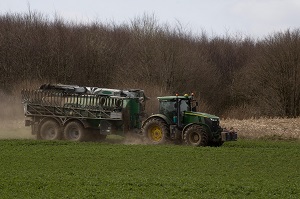![]() Energy Dependence in Food Production is a news and information topic monitored and covered by: Prepper Watch – Food Concerns
Energy Dependence in Food Production is a news and information topic monitored and covered by: Prepper Watch – Food Concerns
Introduction
In an increasingly energy-dependent world, food production, transportation, and storage are highly vulnerable to fluctuations in energy prices. For preppers, it is critical to anticipate potential disruptions in the food supply due to energy shortages or spikes in fuel prices. The interconnections between energy, food production, and transportation create vulnerabilities that need to be addressed by individuals and communities aiming for self-sufficiency. This blog will explore how preppers can take action to prepare for a future where energy reliance in food production may become unsustainable, how to adapt systems for resilience, and how to future-proof food production methods.
Understanding the Energy Dependence of Food Production
The process of food production, from farming to transportation, relies heavily on energy. Modern farming methods depend on fuels such as gasoline, diesel, and electricity to power machinery, irrigation systems, greenhouses, and transportation fleets. Moreover, energy is required for food processing, storage, and refrigeration, creating a complex web of energy dependencies that tie food production to fossil fuel availability.
- Farming Equipment and Machinery: Tractors, harvesters, and irrigation pumps all require fuel or electricity to operate. These machines increase farming efficiency, making it possible to scale production. Without energy, manual labor becomes the fallback, but it is far less efficient and could reduce the food output significantly.
- Transportation and Distribution: Transportation plays a major role in the global food supply chain. Trucks, trains, and ships are used to move raw materials and finished products across vast distances. Transportation costs are often tied to fuel prices, so any disruption in the energy supply can lead to severe price spikes for food, further exacerbating food insecurity.
- Processing and Storage: From canning factories to refrigerated warehouses, much of the food processing and storage infrastructure depends on continuous energy. Energy disruptions, particularly in the form of power outages or fuel shortages, could affect the availability of processed foods or even the ability to store perishables, leading to rapid spoilage.
Given these vulnerabilities, preparing for energy dependency in food production is crucial for preppers who want to ensure a steady food supply even in times of crisis.
Reducing Energy Dependence on the Homestead
Transitioning to Low Energy or Renewable Energy Systems
To reduce dependence on external sources of energy, preppers should consider switching to renewable energy sources, including solar, wind, and micro-hydro systems. These can be used to power essential systems on the homestead, including water pumps, lights, and even some farming machinery.
- Solar Power: Installing solar panels can significantly reduce reliance on grid electricity. Solar power can also be used to run irrigation systems, greenhouses, and essential household appliances. Preppers can store excess energy in batteries for use during cloudy days or at night.
- Wind and Micro-Hydro: For those in areas with strong wind or access to flowing water, wind turbines or micro-hydro generators provide reliable off-grid energy. These systems can be particularly beneficial for powering larger loads such as water pumps for irrigation or running livestock watering systems.
- Backup Power Solutions: In the event of a larger energy crisis, backup solutions such as generators running on biofuels or propane can provide an emergency power supply for essential systems, including refrigeration and heating.
Implementing Low-Energy Farming Techniques
Reducing energy consumption on the farm is essential for prepping. By adopting more sustainable, low-energy farming methods, preppers can become less reliant on fossil fuels.
- Permaculture: This approach to farming focuses on creating self-sustaining ecosystems. By mimicking natural systems, permaculture reduces the need for external inputs such as fertilizers, pesticides, and energy-intensive machinery. It promotes food forests, crop rotation, and minimal tillage, all of which reduce energy demands.
- No-Till Farming: This method involves minimizing the disturbance of the soil. By avoiding tilling, the need for energy-intensive machinery is reduced, and the soil retains its natural structure and moisture, further reducing the need for irrigation and energy.
- Biological Pest Control: Instead of relying on chemical pesticides that require significant energy to produce and distribute, preppers can use natural pest management strategies, such as introducing beneficial insects or using physical barriers to protect crops.
Reducing Energy Use in Greenhouses and Indoor Growing
Greenhouses allow for year-round food production, but traditional greenhouses often require significant amounts of energy for heating and cooling. To reduce energy consumption in greenhouses, preppers can:
- Use Passive Solar Greenhouses: These greenhouses are designed to capture and retain heat from the sun. They can be built into hillsides or orientated to maximize sunlight exposure, reducing the need for external heating during winter.
- Thermal Mass: Incorporating materials that absorb heat during the day and release it at night can help stabilize temperatures in the greenhouse without the need for active heating systems.
- Hydroponics and Aquaponics: These soil-less farming methods can be energy-efficient, especially when paired with renewable energy sources. They allow for high-density food production, making them ideal for small homesteads or urban prepping.
Establishing Sustainable Food Production Methods
Grow Your Own Food
Growing food locally is one of the best ways to reduce dependence on large-scale energy-intensive food production systems. Preppers should focus on producing nutrient-dense foods that require fewer resources to grow.
- Heirloom Crops: Growing heirloom varieties of fruits and vegetables reduces dependence on genetically modified (GM) seeds that often require more energy for production and transportation. These seeds are naturally adapted to local climates, reducing the need for external inputs such as fertilizers and pesticides.
- Livestock Management: Raising livestock such as chickens, goats, or cows requires food and water, but it also provides manure for fertilizing crops and can serve as a protein source. Implementing rotational grazing and building a closed-loop system can help minimize energy inputs for animal husbandry.
- Composting and Vermiculture: Composting organic waste and raising worms for vermiculture can produce nutrient-rich soil amendments without the need for chemical fertilizers. These organic practices promote sustainable agriculture with minimal energy use.
Food Preservation and Storage
Energy dependence does not end at food production; it extends to food storage. Preppers can take steps to reduce reliance on electricity for preserving food by adopting traditional preservation methods.
- Canning and Drying: Canning allows preppers to preserve surplus food for long periods. Solar dehydrators can be used for drying fruits, vegetables, and herbs without the need for electric-powered dehydrators. These methods can be coupled with root cellars, which offer a natural solution for storing food without refrigeration.
- Fermentation and Pickling: These processes involve using natural processes to preserve food, such as lacto-fermentation for vegetables. These techniques require little energy and result in nutritious, shelf-stable food.
Community-Level Preparation
Building a Local Resilient Food System
Preppers should not only focus on individual preparedness but also on community resilience. A community-based approach can reduce the collective dependence on centralized energy systems and food supply chains. By sharing resources, skills, and labor, a prepper community can create a self-sustaining, energy-efficient food system.
- Community Gardens: Urban and rural communities can establish gardens that grow food collectively. These gardens can be solar-powered, use rainwater collection systems, and integrate permaculture principles to minimize energy use while providing fresh produce.
- Food Co-Ops: Establishing cooperative food systems ensures that community members can access affordable, locally produced food even when energy prices soar. Co-ops can focus on growing, processing, and preserving food sustainably, reducing the need for long-distance transportation.
- Seed Sharing and Local Knowledge Networks: By creating networks to share seeds, tools, and knowledge, prepping communities can ensure that everyone has the resources they need to produce food with minimal energy inputs.
Energy Independence Through Bartering and Mutual Aid
Bartering and mutual aid networks are essential for preppers looking to reduce their reliance on traditional markets, which are vulnerable to fuel price spikes. In an energy-crisis scenario, goods and services can be exchanged without the need for money or fuel. Preppers can exchange locally grown food, water filtration systems, energy-efficient appliances, and labor for goods they might not be able to produce themselves.
Preparing for Long-Term Disruptions
Stockpiling Non-Energy Dependent Food Sources
In the event of severe energy disruptions, preppers should have a stockpile of non-perishable food items that do not rely on energy-intensive systems for production, transportation, or storage. This includes items like:
- Grains (rice, wheat, oats): These are energy-dense foods that store well for long periods and can be used to sustain individuals and families for extended periods.
- Dried Legumes and Beans: These are an excellent source of protein and can be stored for years in airtight containers.
- Canned Goods: Though canned goods require energy to produce, they are shelf-stable for a long time and can be used to supplement home-grown food during an energy crisis.
Conclusion
Energy dependence is a significant challenge for food production systems, but preppers can take proactive steps to reduce their reliance on vulnerable energy sources. By adopting low-energy farming techniques, investing in renewable energy systems, growing food locally, and building community-based food systems, preppers can prepare for the energy crises that may disrupt global food supplies. Through careful planning, adaptation, and collaboration, preppers can ensure a steady, self-sufficient food supply regardless of future energy uncertainties.

